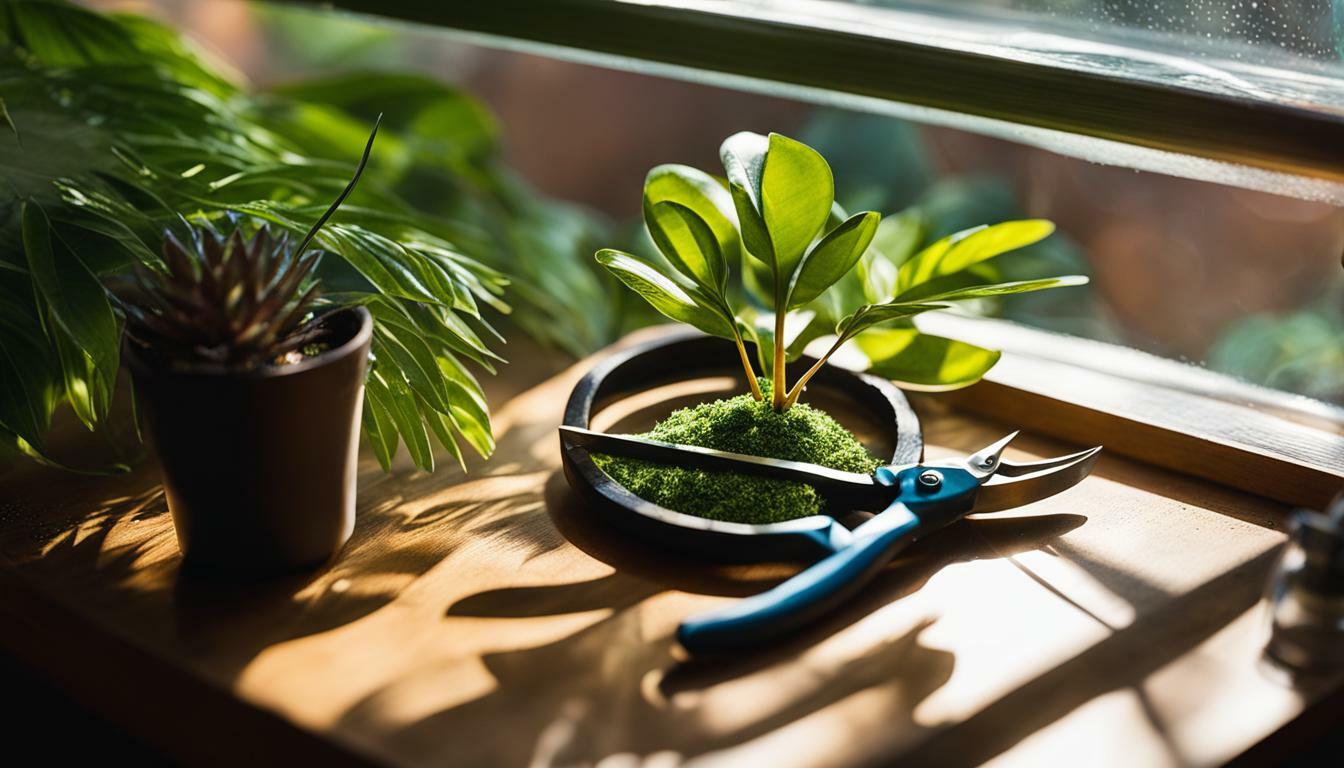Terrarium care is essential for maintaining the health and beauty of your mini-ecosystem. Pruning plays a vital role in ensuring the longevity and vitality of your terrarium plants. By carefully trimming and shaping your plants, you can promote healthy growth, prevent overgrowth, and enhance the overall aesthetics of your terrarium.
- Regular pruning is crucial for maintaining the shape and health of your terrarium plants.
- Pruning prevents overgrowth, which can lead to nutrient depletion and overcrowding.
- Proper pruning techniques help promote proper nutrient distribution and airflow.
- Sterilizing your pruning tools before use is essential to prevent the spread of diseases.
- When pruning overgrown plants, trim back excessive growth while preserving the overall health of the plant.
By understanding and implementing these terrarium care pruning tips and techniques, you can ensure your terrarium thrives and remains a beautiful and vibrant addition to your home or office.
Understanding Terrariums: Types and Basic Care
Before delving into pruning techniques, it’s important to understand the different types of terrariums and the fundamental care they require. Terrariums are small indoor gardening containers that provide a controlled environment for plants to thrive. There are two main types of terrariums: open and closed.
An open terrarium is a glass container that is not fully enclosed, allowing for air circulation. These terrariums require regular watering as the moisture evaporates quickly. It’s important to monitor the moisture levels and water accordingly to prevent the plants from becoming too dry.
On the other hand, closed terrariums are fully enclosed with a lid, creating a miniature ecosystem. The closed environment creates a natural rain cycle, where moisture condenses on the sides of the glass and then drips back down to the plants. Closed terrariums require less frequent watering and can sustain themselves for longer periods. However, they do need to be opened every few weeks to refresh the air inside and prevent the growth of mold or other plant diseases.
Regardless of the type of terrarium, both require indirect light. Direct sunlight can scorch the delicate plants and cause irreparable damage. Place your terrarium in a location where it will receive bright, indirect sunlight throughout the day. If your space lacks natural light, you can use artificial grow lights to provide the necessary light for the plants to thrive.
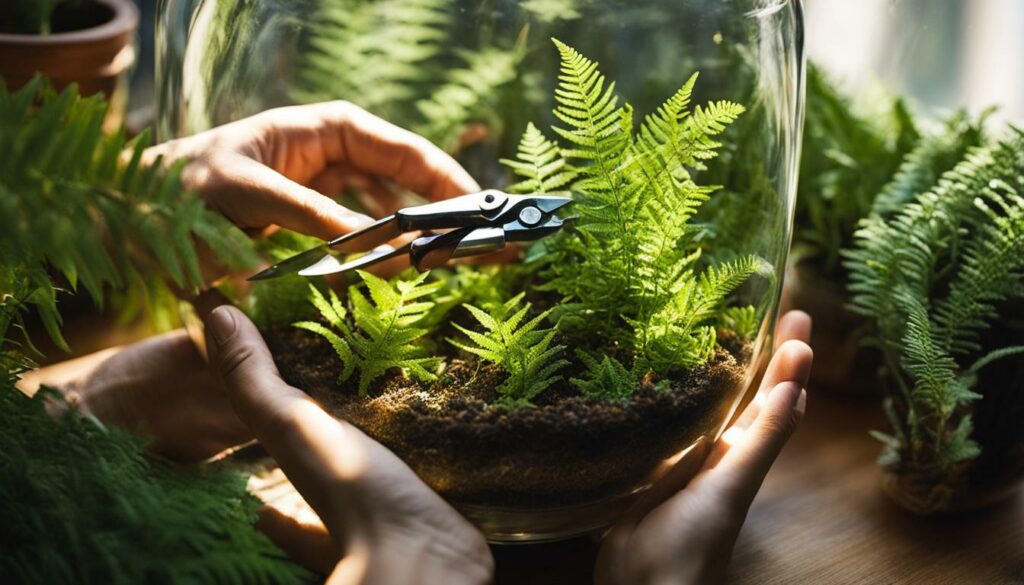
To summarize, terrariums are small indoor gardening containers that come in two main types: open and closed. Open terrariums require regular watering, while closed terrariums create their own rain cycle. Both types need indirect light to prevent plant damage. Understanding these basic care requirements is the first step towards successfully caring for your terrarium plants.
The Importance of Pruning in Terrarium Care
Pruning is a crucial aspect of terrarium care, as it ensures the overall well-being and visual appeal of your miniature garden. Regular pruning helps maintain the shape and health of terrarium plants, prevents overgrowth, and promotes proper nutrient distribution. By removing dead or damaged foliage, you create a healthier environment for the remaining plants to thrive.
Terrarium plants can quickly become crowded within the limited space of their container. Pruning allows you to control their growth and prevent overcrowding, which can lead to competition for resources and hinder their development. It also helps maintain the desired aesthetic by keeping the plants in proportion and preserving the overall design of your terrarium.
When pruning your terrarium plants, it is important to use sterile tools to prevent the spread of disease and infection. Before each use, sterilize your pruning shears or scissors by wiping them with rubbing alcohol or a diluted bleach solution. This reduces the risk of transmitting any harmful pathogens to the plants.
| Pruning Tips | Pruning Techniques |
|---|---|
|
|
Remember that each terrarium plant has unique pruning requirements. Some plants may require more frequent trimming, while others may need minimal intervention. Understanding the specific needs of your plants will help you achieve optimal results and create a harmonious terrarium ecosystem.
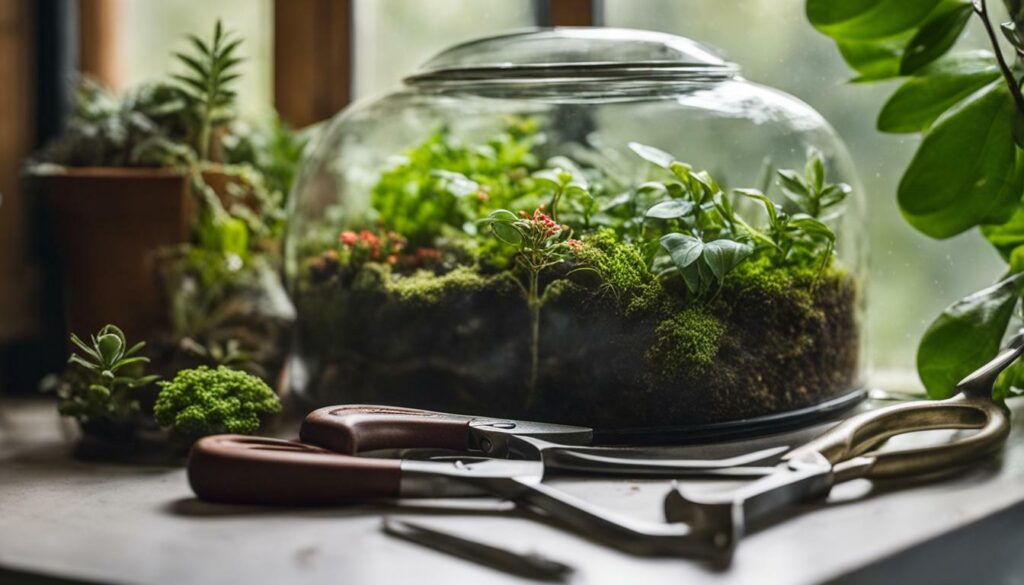
To successfully prune your terrarium plants, it’s essential to have the right tools and knowledge of proper pruning techniques. Pruning helps keep your terrarium plants healthy, promotes growth, and enhances the overall aesthetics of your mini-ecosystem. Here are some essential tools and techniques to master for effective terrarium plant pruning.
Sterilized Tools
Before you begin pruning, make sure to sterilize your tools to prevent the spread of diseases and ensure the health of your plants. Use rubbing alcohol or a 10% bleach solution to clean your pruning shears, scissors, or any other tools you plan to use. This step is crucial to avoid introducing harmful bacteria or fungi to your terrarium.
Pruning Techniques
The technique you use to prune your terrarium plants will depend on the specific plant species and its growth habit. Here are some common pruning techniques:
- Pinching: This involves using your fingers to pinch off the tips of new growth. Pinching helps promote bushier growth and prevents your terrarium plants from becoming leggy.
- Selective Pruning: Selective pruning involves removing specific branches or stems to shape your plants. This technique is useful for maintaining the desired size and form of your terrarium plants.
- Thinning: Thinning involves removing entire branches or stems to improve air circulation and light penetration. This technique is especially important for densely planted terrariums.
- Deadheading: Deadheading involves removing spent flowers to encourage the growth of new blooms. This technique is particularly useful for flowering terrarium plants.
Remember to always prune just above a leaf node or bud to promote healthy growth. Avoid cutting too close to the main stem, as this can cause damage and hinder regrowth.
| Tool | Usage |
|---|---|
| Pruning Shears | Ideal for cutting through thicker stems or branches. |
| Scissors | Perfect for precise trimming of smaller leaves and stems. |
| Pruning Snips | Great for delicate pruning tasks and reaching tight spaces. |
| Long-Handled Pruners | Recommended for trimming terrarium plants with long, trailing stems. |
By using the proper tools and techniques, you can ensure that your terrarium plants remain healthy, well-shaped, and vibrant. Take your time, observe your plants’ growth patterns, and adjust your pruning methods accordingly. With practice, you’ll become a master at pruning terrarium plants and enjoy the beauty and vitality of your mini indoor garden.
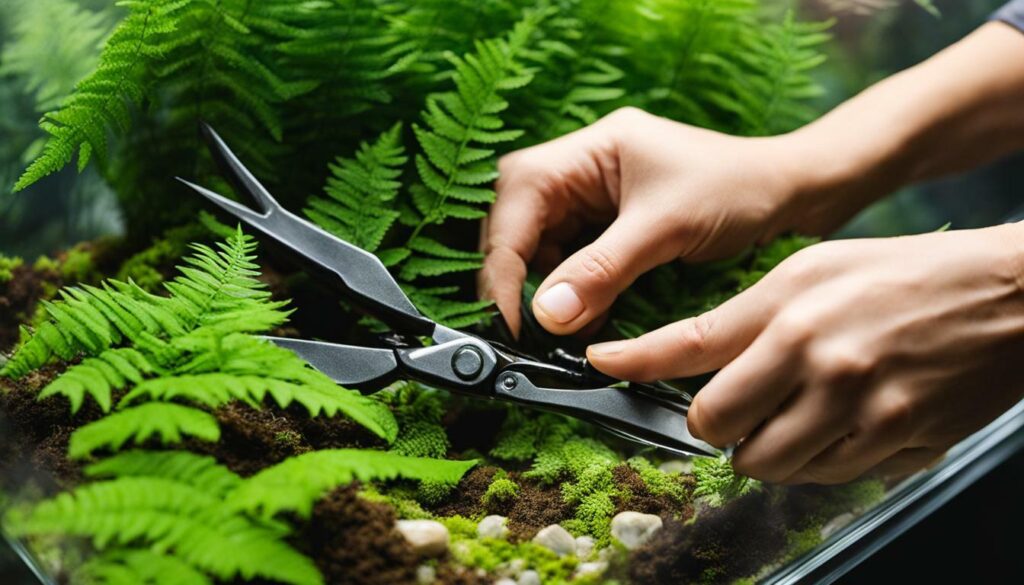
Overgrown plants can disrupt the balance and aesthetics of your terrarium, but with the right pruning techniques, you can restore their beauty and vitality. Pruning is an essential part of terrarium care, helping to maintain the shape and health of your plants, prevent overgrowth, and promote proper nutrient distribution.
Before you begin pruning, it’s important to gather the necessary tools for the task. These may include small pruning shears or scissors, a pair of long-handled tweezers, and a clean, damp cloth for wiping down your tools between cuts. Remember to sterilize your tools beforehand to prevent the spread of disease or pests.
When pruning your terrarium plants, it’s crucial to take a careful and selective approach. Start by removing any dead or yellowing leaves, as these can be a sign of poor health. Trim back excessive growth using clean, angled cuts just above a node or leaf junction. This will encourage new growth and maintain the overall shape of the plant.
| Pruning Tips: | Pruning Techniques: |
|---|---|
|
|
Remember to step back and assess the overall appearance of your terrarium after pruning. When done correctly, your plants should regain their beauty and fit harmoniously within the terrarium environment.
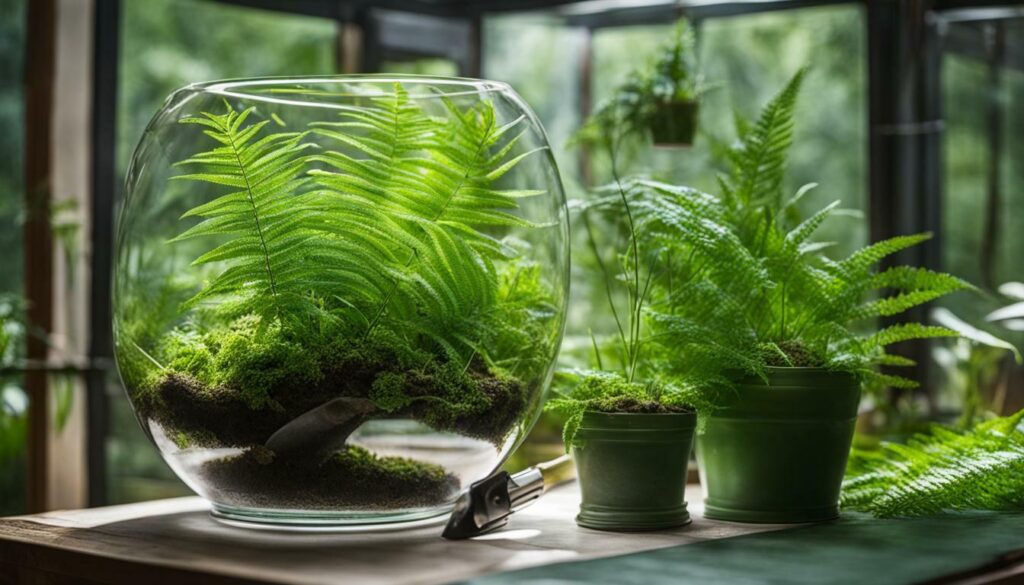
“Pruning is like giving your terrarium plants a haircut. It helps them stay healthy and well-groomed, ensuring they flourish within their mini-ecosystem.” – Terrarium Enthusiast Magazine
Removing Dying Plants from Your Terrarium
Even with proper care, some plants may decline in a terrarium. Knowing when and how to remove dying plants is crucial for maintaining the overall health of your mini-ecosystem.
Dying plants can have a negative impact on the balance of your terrarium. They can compete with healthy plants for resources, attract pests, and create an unsightly appearance. To ensure your terrarium remains vibrant and thriving, follow these steps to remove dying plants:
- Identify the problem: Look for signs of a dying plant, such as yellowing leaves, wilting, or a general decline in growth. If you notice any of these symptoms, it’s time to take action.
- Remove the plant: Carefully remove the dying plant from the terrarium. Use clean, sterilized tools to avoid spreading any potential infections or diseases to other plants.
- Inspect the roots: Examine the roots of the dying plant. If they are rotted or mushy, it’s a sign of overwatering or poor drainage. If the roots are healthy, the issue may be related to inadequate light, nutrient deficiencies, or other factors.
- Replace or adjust: Depending on the cause of the plant’s decline, you may need to adjust the terrarium’s conditions, such as providing more or less water, adjusting the light exposure, or adding nutrients. If the plant cannot be salvaged, consider replacing it with a healthier alternative.
Regularly monitoring and addressing the health of your terrarium plants is essential for creating a thriving indoor garden. By removing dying plants promptly and taking appropriate steps to prevent further decline, you can maintain a beautiful, balanced terrarium ecosystem.
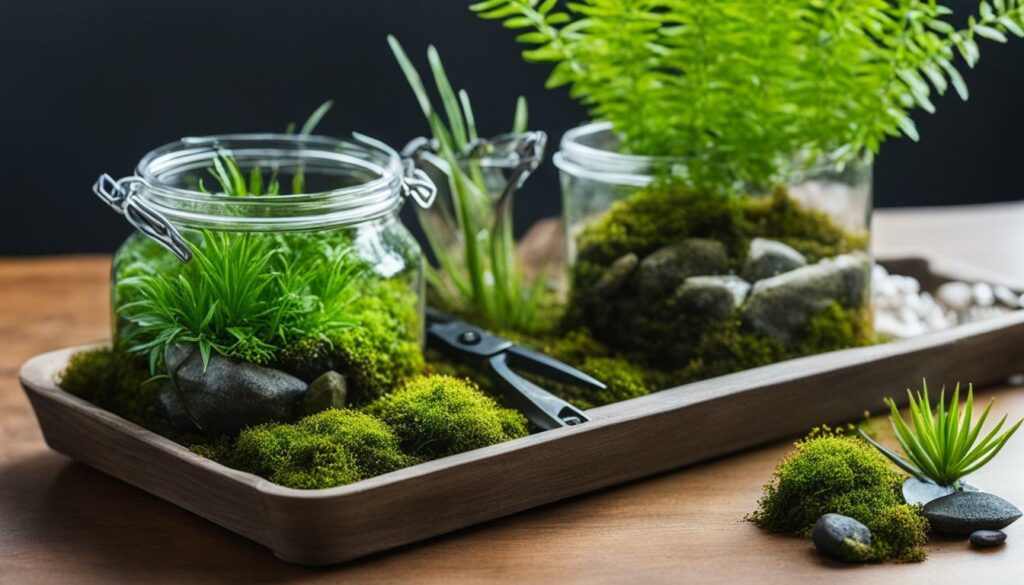
| Signs of a Dying Plant | Possible Causes |
|---|---|
| Yellowing leaves | Overwatering, nutrient deficiencies |
| Wilting | Inadequate light, temperature stress |
| General decline in growth | Poor soil quality, pest infestation |
Planting in Closed Terrariums: Tips and Considerations
Closed terrariums require specific considerations when it comes to planting. Following these tips will help ensure the success of your closed terrarium.
First, it’s essential to use sterile soil in closed terrariums to prevent the growth of harmful bacteria or fungi. Sterilized soil can be easily purchased or prepared at home by baking regular potting soil in the oven at 180°F for about 30 minutes. Remember to let the soil cool before using it in your terrarium.
Before planting, it’s recommended to rinse the plants to remove any excess soil and reduce the risk of introducing unwanted pests into your closed terrarium. Gently wash the roots under running water, taking care not to damage them. This step will help keep the terrarium environment clean and healthy.
When selecting plants for your closed terrarium, choose those that thrive in high humidity and lower light conditions. Some popular choices include ferns, mosses, and tropical plants like pothos and fittonia. These plants will not only withstand the enclosed environment of a closed terrarium but also provide a lush and visually appealing display.
Terrarium Plant Selection Guide for Closed Terrariums
| Plant | Light Requirements | Humidity Requirements |
|---|---|---|
| Ferns | Low to medium indirect light | High humidity |
| Mosses | Low to medium indirect light | High humidity |
| Pothos | Low to medium indirect light | Moderate humidity |
| Fittonia | Low to medium indirect light | High humidity |
Remember to provide enough space between plants to allow for growth and airflow within the closed terrarium. Keep in mind that over time, some plants may outgrow the terrarium, so regular pruning will be necessary to maintain the desired size and shape.
By following these tips and selecting the right plants, you’ll be able to create a beautiful and thriving closed terrarium that brings a touch of nature indoors.
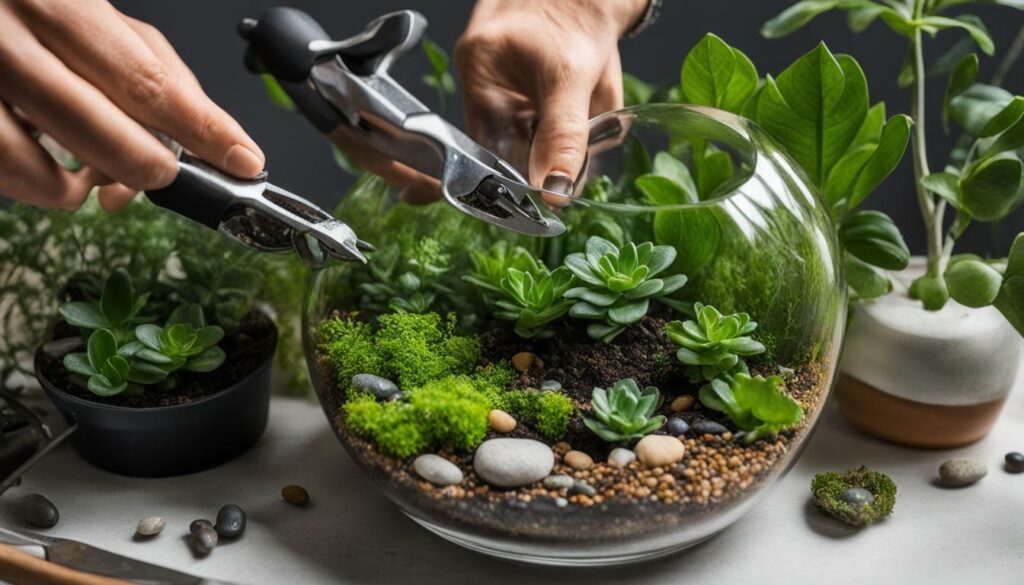
Contrary to popular belief, most terrarium plants do not require regular fertilization. Understanding the role of fertilization in terrarium care is essential for maintaining a healthy and balanced environment. Terrariums are self-contained ecosystems that create their own mini rain cycle, recycling moisture and nutrients. The plants inside the terrariums are adapted to this closed environment and have specific nutrient requirements that can be met without the need for additional fertilization.
However, there are instances when fertilization may be necessary, such as when plants show signs of nutrient deficiency or when you’re growing specific types of plants that require richer soil. In these cases, it’s important to select a fertilizer that is suitable for terrarium use, as regular plant fertilizers may contain chemicals or nutrients that can disrupt the delicate balance of the terrarium ecosystem.
When fertilizing terrarium plants, it’s crucial to follow the recommended dosage instructions carefully, as over-fertilization can be detrimental to the health of the plants. Too much fertilizer can lead to excessive growth, which can overcrowd the terrarium and deprive other plants of light and resources. It’s always better to err on the side of caution and slightly under-fertilize rather than over-fertilize your terrarium plants.
In summary, while most terrarium plants do not require regular fertilization, understanding the role of fertilization in terrarium care is important for maintaining a healthy and balanced environment. If fertilization becomes necessary, use a fertilizer specifically formulated for terrarium use and follow the instructions carefully to avoid over-fertilization. By providing the right amount of nutrients, your terrarium plants will thrive and contribute to the beauty and harmony of your miniature indoor garden.
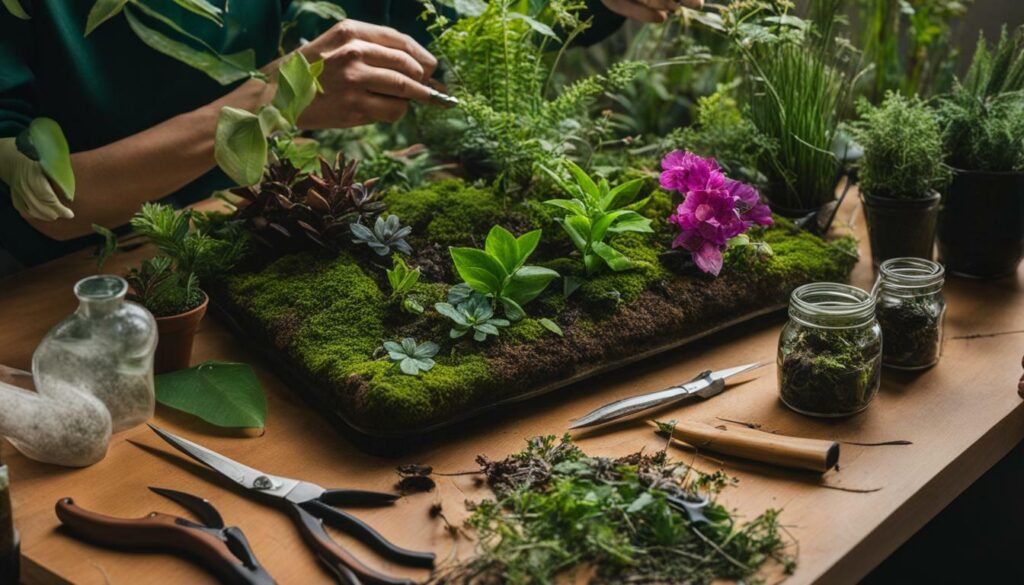
| Key Points: |
|---|
| Most terrarium plants do not require regular fertilization. |
| Understanding the role of fertilization in terrarium care is important for maintaining a healthy and balanced environment. |
| If fertilization becomes necessary, use a fertilizer specifically formulated for terrarium use and follow the instructions carefully to avoid over-fertilization. |
Cleaning and Maintaining Terrarium Glass
Clean and clear glass is essential for allowing optimal sunlight to reach your terrarium plants. Follow these steps to keep your terrarium glass sparkling and your plants thriving.
Step 1: Gather your supplies
- Clean, lint-free cloth
- Mild soap or glass cleaner
- Water
Step 2: Remove any debris
Start by gently removing any visible debris from the glass, such as dust or dirt particles. Use a soft brush or cloth to wipe away the dirt, being careful not to scratch the glass.
Step 3: Prepare your cleaning solution
Mix a small amount of mild soap or glass cleaner with water in a spray bottle or container. Avoid using harsh chemicals, as they may damage the plants inside the terrarium.
Step 4: Clean the glass
Spray the cleaning solution onto the glass or apply it to your cloth. Gently wipe the glass in a circular motion, ensuring all areas are covered. Pay extra attention to any stubborn stains or smudges.
Step 5: Rinse and dry
Rinse the glass thoroughly with clean water to remove any residue from the cleaning solution. Dry the glass with a clean, lint-free cloth to prevent water spots or streaks.
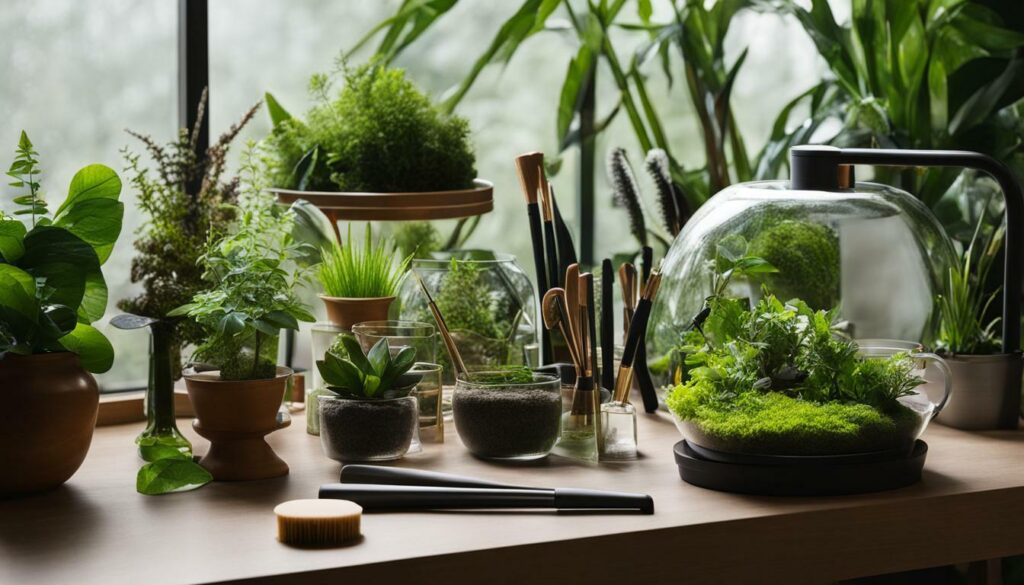
Step 6: Repeat as needed
Regularly clean your terrarium glass to maintain its clarity and ensure that sunlight can penetrate the interior. Depending on the environment, you may need to clean the glass every few weeks or as necessary to keep it looking its best.
By following these simple steps, you can keep your terrarium glass clean and clear, allowing your plants to thrive in their miniature ecosystem.
Caring for Terrariums with Indirect Light
Proper light exposure is crucial for the health of your terrarium plants. Discover how to care for your terrarium when it is located in an area with indirect light.
Terrariums are small indoor gardens that require the right amount of light to thrive. When placed in an area with indirect light, it’s important to provide alternative ways to ensure your plants receive adequate light. One option is to position your terrarium near a north-facing window, where it can receive bright, filtered light throughout the day.
Another option is to use artificial lighting, such as fluorescent or LED grow lights. These lights can be set up above your terrarium, providing the necessary light spectrum for plant growth. It’s important to keep the lights on for approximately 10-12 hours per day, simulating the natural daylight cycle.
Additionally, consider rotating your terrarium regularly to expose all sides of the plants to the light source. This will promote even growth and prevent plants from leaning towards the light. Remember, direct sunlight can harm your terrarium plants, so it’s best to avoid placing them in direct sunlight.
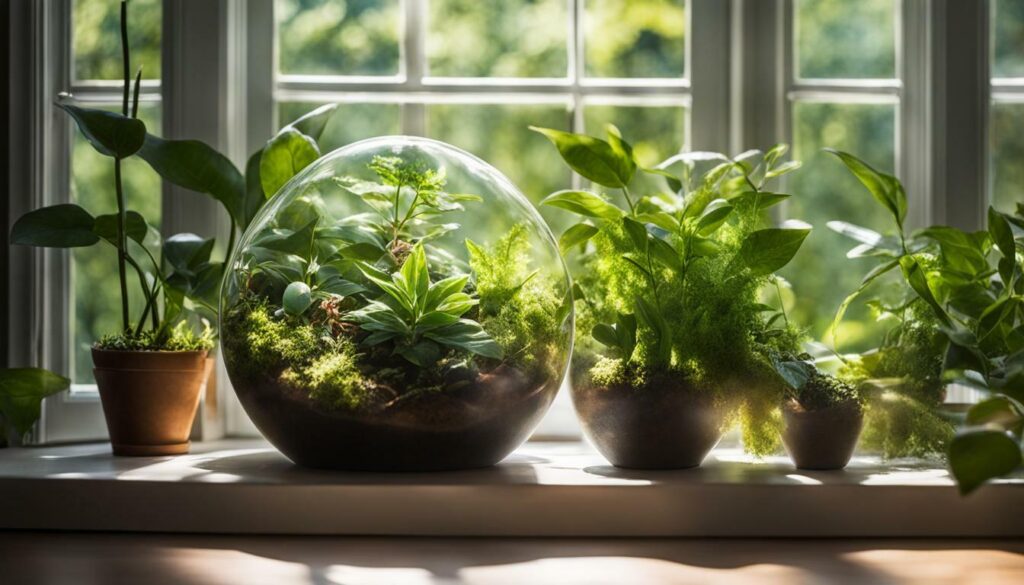
| Tip | Care Requirement |
|---|---|
| 1 | Provide bright, filtered light near a north-facing window. |
| 2 | Use artificial lighting, such as fluorescent or LED grow lights, positioned above your terrarium. |
| 3 | Rotate your terrarium regularly to ensure all sides of the plants receive adequate light. |
| 4 | Avoid placing your terrarium in direct sunlight. |
Proper light exposure is essential for the health and growth of your terrarium plants. By taking the necessary steps to provide indirect light, you can create a thriving mini-garden that brings beauty and tranquility to your indoor space.
What Are the Best Pruning Tips and Techniques for Terrarium Care in Glass Containers?
When it comes to master terrarium care basics in glass containers, pruning is essential for maintaining a healthy and beautiful terrarium. Use small, sharp scissors to carefully remove any dead or decaying foliage. Trim back overgrown plants to maintain the desired size and shape. Regular pruning will help your terrarium thrive.
Refreshing Closed Terrariums: Why and How
Closed terrariums create a self-sustaining ecosystem, but periodic refreshing is necessary to ensure the longevity and vibrancy of your miniature garden. While closed terrariums are designed to recycle their own moisture, over time, the air inside can become stagnant, leading to a buildup of mold and other harmful microorganisms. Refreshing the terrarium allows for the exchange of stale air with fresh, oxygen-rich air, promoting the health of the plants and preventing the growth of harmful bacteria.
To refresh a closed terrarium, start by carefully opening the lid or removing any covering. This should be done every few weeks or whenever the terrarium begins to appear foggy or moldy. Allow the terrarium to air out for a few hours in a well-ventilated area, ensuring that it is not exposed to direct sunlight. During this time, you can gently wipe down the interior glass with a soft cloth to remove any dust or condensation.
After the terrarium has had a chance to air out, it’s time to reintroduce fresh air and moisture. Lightly mist the plants and the soil with a spray bottle filled with filtered water. Avoid overwatering, as excess moisture can lead to root rot and other plant diseases. Once the terrarium has been misted, carefully replace the lid or covering, ensuring it is securely in place.
Remember to regularly observe your closed terrarium for any signs of distress or imbalance. Watch for excessive condensation, which can indicate too much moisture, or wilted, yellowing plants, which may suggest a lack of water or sunlight. By taking the time to refresh your closed terrarium, you can provide the optimal conditions needed for your plants to thrive and create a stunning, self-contained ecosystem in your home.
Expert Tip:
“When refreshing your closed terrarium, make sure to use filtered water to avoid introducing any chemicals or impurities that could harm your plants. This ensures that your terrarium remains a healthy and balanced environment for your miniature garden.”
Table: How to Refresh a Closed Terrarium
| Step | Instructions |
|---|---|
| 1 | Carefully remove the lid or covering of the terrarium. |
| 2 | Air out the terrarium in a well-ventilated area for a few hours. |
| 3 | Gently wipe down the interior glass with a soft cloth. |
| 4 | Mist the plants and soil lightly with filtered water. |
| 5 | Replace the lid or covering, ensuring it is securely in place. |
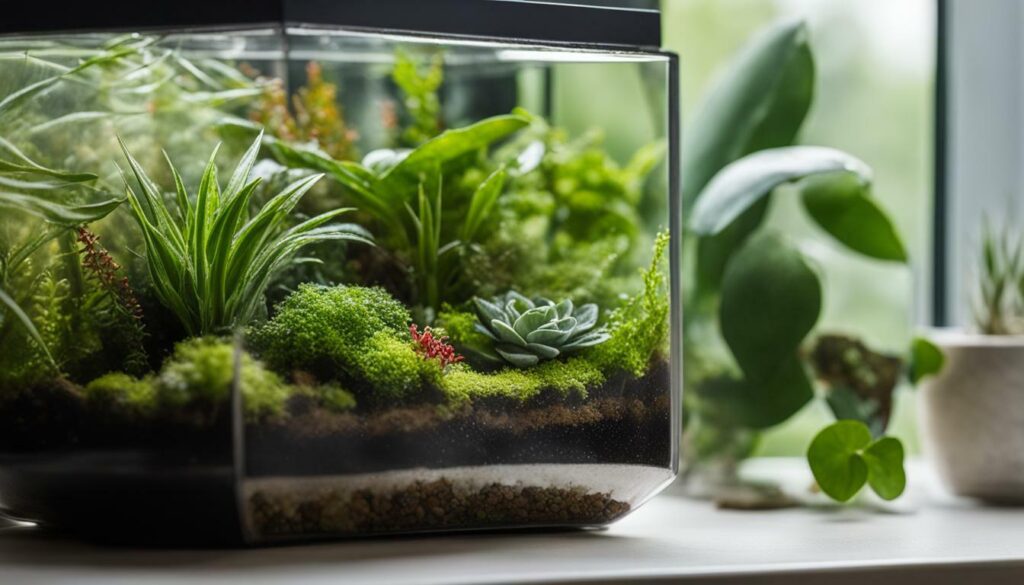 Note: All images are for illustrative purposes only.
Note: All images are for illustrative purposes only.By implementing the pruning tips and techniques outlined in this guide, you can become a terrarium care expert and create a captivating, healthy, and visually appealing mini-ecosystem. Terrariums are small indoor gardening containers that hold plants, and they come in two types: open and closed. Closed terrariums are fully enclosed with a lid, creating their own rain cycle, while open terrariums require regular watering.
Regardless of the type of terrarium you choose, it’s important to provide indirect light to your plants, as direct sunlight can burn them. Cleaning the terrarium glass occasionally is essential to allow sunlight to reach the plants and ensure their proper growth. Remember to also open closed terrariums every few weeks to refresh the air inside.
Pruning plays a crucial role in maintaining healthy terrarium plants. Before you start pruning, make sure to sterilize your tools to prevent the spread of diseases. Trim overgrown plants carefully, following the specific techniques that are suitable for each plant type. Additionally, promptly remove dying plants from your terrarium to maintain a healthy environment for the remaining plants.
When planting in closed terrariums, it’s important to use sterile soil and rinse the plants before placing them inside to prevent contamination. Avoid fertilization as most terrarium plants do not require it. Instead, focus on selecting plants that thrive in the specific type of terrarium you are creating to ensure their long-term health and success.
FAQ
What are terrariums?
Terrariums are small indoor gardening containers used to hold plants. They come in two types: open and closed.
What is the difference between open and closed terrariums?
Closed terrariums are fully enclosed with a lid, creating their own rain cycle, while open terrariums require regular watering.
How much light do terrariums need?
Terrariums need indirect light, as direct sunlight can burn the plants.
How often should closed terrariums be opened?
Closed terrariums should be opened every few weeks to refresh the air.
How should terrarium glass be cleaned?
Terrarium glass should be cleaned occasionally to allow sunlight to reach the plants.
Why is pruning necessary in terrarium care?
Pruning helps maintain healthy plants, prevents overgrowth, and promotes proper nutrient distribution.
How should tools be sterilized before pruning terrarium plants?
Tools should be sterilized beforehand to prevent the spread of diseases. You can use rubbing alcohol or a sterilizing solution.
How do I prune overgrown terrarium plants?
To prune overgrown plants, trim the excessive growth carefully without harming the overall plant health.
What should I do if a plant is dying in my terrarium?
Identify and remove the dying plant promptly to maintain a healthy environment in your terrarium.
What should I consider when planting in a closed terrarium?
When planting in a closed terrarium, use sterile soil and rinse the plants before placing them inside. Select plants that thrive in closed terrarium conditions.
Do terrarium plants require fertilization?
Most terrarium plants do not require fertilization. Over-fertilization can be detrimental to the delicate ecosystem inside the terrarium.
How should I clean and maintain the terrarium glass?
To maintain proper sunlight penetration, clean the terrarium glass regularly by removing dust and debris.
How should I care for terrariums placed in areas with indirect light?
Terrariums placed in areas with indirect light should still receive adequate light. Seek alternative ways to provide sufficient brightness.
Why and how should closed terrariums be refreshed?
Closed terrariums should be periodically opened and aerated to maintain a healthy environment.

